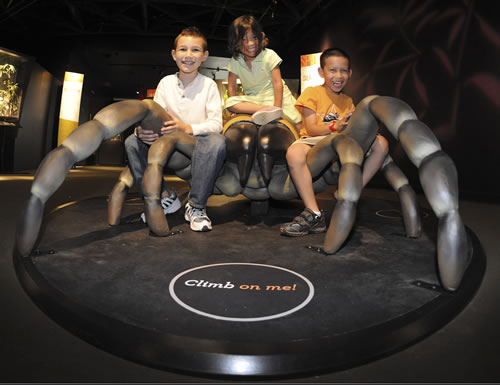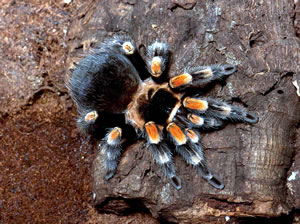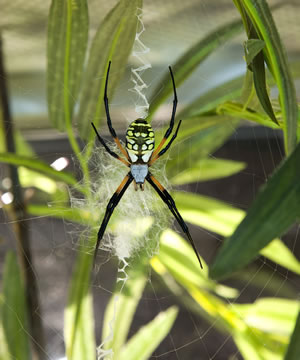MUSEUM REVIEW
‘Spiders Alive!’ at American Museum of Natural History
By Jan Aaron

This climbable spider model is 50 times the life size of a trapdoor spider
(Cyclocosmia torreya).
(© AMNH\R. Mickens)
“Ooh, cool,” said a girl scout, peering at a live spider clinging to the hand of a staff member at the American Museum of Natural History’s new exhibition, “Spiders Alive!” The exhibition is full of surprises, like museum staff handling live spiders, a climbable spider model 50 times life size, and a rare 100-million-year-old fossil of a spider in limestone.
 Mexican red knee (Brachypelma smithi): This stunning tarantula, which lives mainly on the Pacific coast of Mexico, resides in burrows, hurrying out to prey oninsects, small frogs, lizards, and mice.
(© AMNH\R. Mickens)
Mexican red knee (Brachypelma smithi): This stunning tarantula, which lives mainly on the Pacific coast of Mexico, resides in burrows, hurrying out to prey oninsects, small frogs, lizards, and mice.
(© AMNH\R. Mickens)Kids and adults come face to face with 20 species of spiders at the exhibition, which teaches them about arachnid habitats, anatomy, diversity and behavior. For instance, less than one percent of the world’s 43,000 spider species have venom dangerous to humans. Spiders are also among planet’s most adaptable animals; from remote rainforests to sophisticated cities, spiders find homes everywhere on the planet but Antarctica.
“This exhibition also gives us a chance to showcase some of our recent research, both in the field and in the lab,” said Norman Platnick, curator emeritus in the Division of Invertebrate Zoology and the curator for “Spiders Alive!”
The exhibition strives to teach us not to fear spiders by explaining how crucial they are to insect populations worldwide, as well as the conservation methods researchers use to protect them. For instance, without spiders, insect populations would explode. By one estimate, spiders on one acre of woodland can consume more than 80 pounds of insects a year.
 Orb weaver (Argiope sp.)
Orb weaver (Argiope sp.)
Members of this genus are found all around the world and spin large webs that often contain striking designs. Charlotte’s Web author E.B. White, who consulted with a Museum curator while writing the classic children’s book, named the main character Charlotte A. Cavatica after a common orb weaver, Araneus cavaticus.
(© AMNH\R. Mickens)About midway into the exhibition, you can sit on a bench while watching museum experts show and explain the basic anatomy of a spider like the hairy tarantula. Elsewhere, you can view a short video of Platnick’s expedition to study goblin spiders in Ecuador. There’s also a short narrated program about the dazzling variety of spiders, with segments showing spiders in action: a diving bell spider living underwater, a southern black widow spinning silk and an orb weaver constructing its intricate web.
Roaming further you can find a fantastic array of spiders, their habitats reproduced in glass vitrines. Among these are the fishing spiders that rest their forelegs on the surface of the water on the shoreline, trying to sense vibrations from prey. When some edible tidbit gets close, this spider pounces. The wolf spider, an active hunter that searches for food on foot, is aided by sharp vision and the ability to sense vibrations, like those of the beating wing of an insect or the patter of steps on soil. There are spiders that weave silk in a kind of net that is dropped over their victims, and spiders that shoot a foul-smelling spray from their abdomens if disturbed.
Author E.B. White consulted a museum curator when writing the classic children’s book “Charlotte’s Web,” naming the main character Charlotte A. Cavatica, after the common orb weaver spider Araneus cavaticus.
There are many more spiders to discover at the exhibition, which runs through December 2, 2012. Go exploring, find many others, and come away less fearsome and better informed.
The American Museum of Natural History is located at Central Park West at 79th St. Call 212-729-5200 or visit amnh.org for more information.
